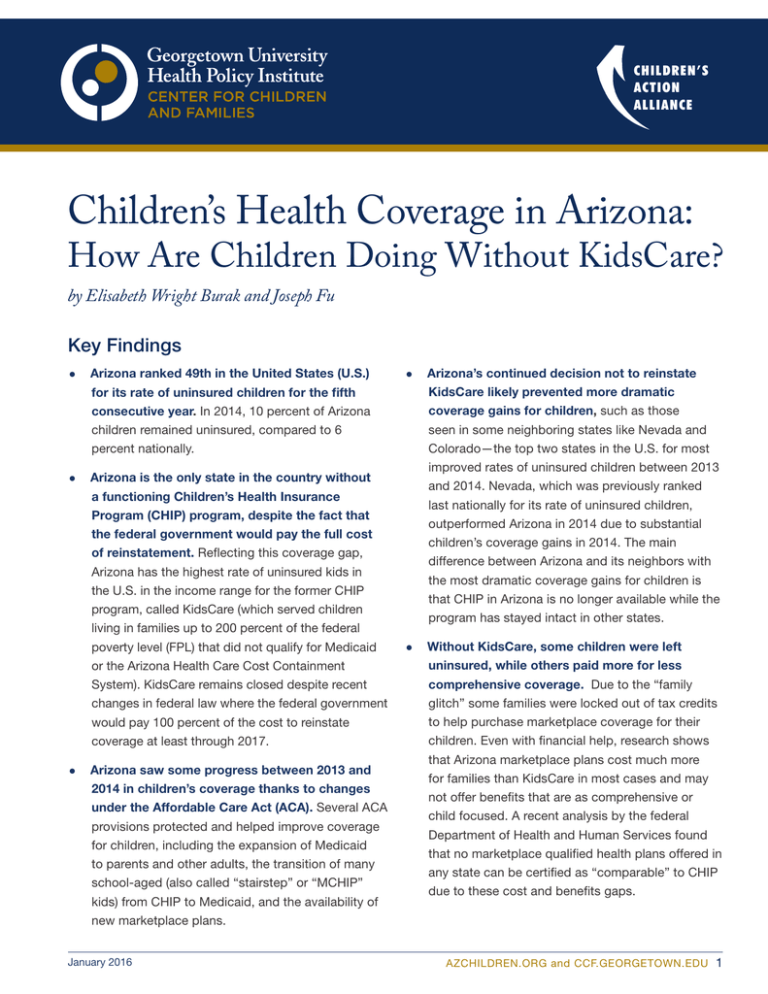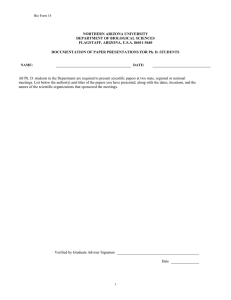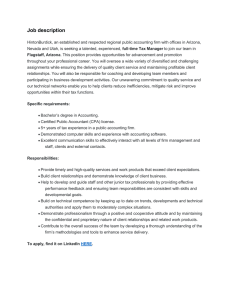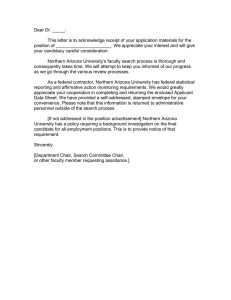Annie E. Casey Foundation
advertisement

CHILDREN’S ACTION ALLIANCE Children’s Health Coverage in Arizona: How Are Children Doing Without KidsCare? by Elisabeth Wright Burak and Joseph Fu Key Findings zz Arizona ranked 49th in the United States (U.S.) for its rate of uninsured children for the fifth consecutive year. In 2014, 10 percent of Arizona children remained uninsured, compared to 6 percent nationally. zz Arizona is the only state in the country without a functioning Children’s Health Insurance Program (CHIP) program, despite the fact that the federal government would pay the full cost of reinstatement. Reflecting this coverage gap, Arizona has the highest rate of uninsured kids in the U.S. in the income range for the former CHIP program, called KidsCare (which served children living in families up to 200 percent of the federal poverty level (FPL) that did not qualify for Medicaid or the Arizona Health Care Cost Containment System). KidsCare remains closed despite recent changes in federal law where the federal government would pay 100 percent of the cost to reinstate coverage at least through 2017. zz Arizona saw some progress between 2013 and 2014 in children’s coverage thanks to changes under the Affordable Care Act (ACA). Several ACA provisions protected and helped improve coverage for children, including the expansion of Medicaid to parents and other adults, the transition of many school-aged (also called “stairstep” or “MCHIP” kids) from CHIP to Medicaid, and the availability of new marketplace plans. January 2016 zz Arizona’s continued decision not to reinstate KidsCare likely prevented more dramatic coverage gains for children, such as those seen in some neighboring states like Nevada and Colorado—the top two states in the U.S. for most improved rates of uninsured children between 2013 and 2014. Nevada, which was previously ranked last nationally for its rate of uninsured children, outperformed Arizona in 2014 due to substantial children’s coverage gains in 2014. The main difference between Arizona and its neighbors with the most dramatic coverage gains for children is that CHIP in Arizona is no longer available while the program has stayed intact in other states. zz Without KidsCare, some children were left uninsured, while others paid more for less comprehensive coverage. Due to the “family glitch” some families were locked out of tax credits to help purchase marketplace coverage for their children. Even with financial help, research shows that Arizona marketplace plans cost much more for families than KidsCare in most cases and may not offer benefits that are as comprehensive or child focused. A recent analysis by the federal Department of Health and Human Services found that no marketplace qualified health plans offered in any state can be certified as “comparable” to CHIP due to these cost and benefits gaps. AZCHILDREN.ORG and CCF.GEORGETOWN.EDU 1 Child Uninsurance Rates in Arizona and the U.S. by Family Income as a Percentage of the Federal Poverty Level (FPL), 2014 1. Reinstate KidsCare. 20.0% Arizona’s child uninsurance rate is highest in the country in this income range. 16.5% 16.0% 12.0% Arizona 12.6% United States average 9.0% 7.8% 8.0% 8.7% 4.0% 2. Ensure that marketplace Qualified Health 3.2% Under 138% 138-199% 200-399% Former KidsCare income eligibility range 2.3% Above 400% Rate of Uninsured Childdren for Arizona, Colorado, Nevada, and the U.S. 2008-2014 19.4% 17.8% 17.4% 16.2% 16.6% 15.1% 13.8% 14.9%* 12.0%* 12.8% 10.2%* 10.1% 9.3% 8.6%* 8.0%* 12.9% 13.2% 11.9%* 9.4% 7.5%* 8.8% 7.2%* 8.2% 7.1% Nevada fell below Arizona’s 10.0%* rate of uninsured 9.6%* children in 2014. 6.0%* 5.6%* 200820092010 2011201220132014 Nevada Arizona Colorado Plans (QHPs) include comprehensive, pediatric benefits at an affordable cost to families. Arizona can improve future marketplace plans to ensure they are child-focused and meet the full range of pediatric needs in accordance with the American Academy of Pediatrics Bright Futures standards. With an eye toward benefit and cost gaps, Arizona could strengthen state agency oversight and monitoring to ensure marketplace plans are meeting children’s health needs and remain affordable. 3. Protect Medicaid coverage for adults, including parents. Protecting a robust Medicaid expansion is critical to ensuring children maintain coverage and get the care they need. Rollbacks or harmful policy changes that have an effect of coverage losses to parents would have a spillover effect on their children. United States * Indicates one-year change is statistically significant at the 90 percent confidence level. 2 If Arizona leaders moved to reinstate KidsCare, the federal government would pay the full cost of coverage—100 percent—at least through 2017. Taking full advantage of the newly increased match for CHIP under the Medicare Access and CHIP Reauthorization Act will allow the state to make more dramatic gains for children. 6.0% 0.0% What Arizona Can Do to Ensure All Children Have Health Coverage That Meets Their Needs AZCHILDREN.ORG and CCF.GEORGETOWN.EDU To see the complete report, go to www.azchildren.org January 2016




